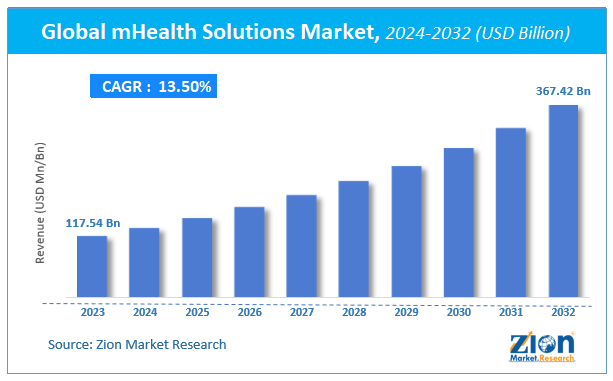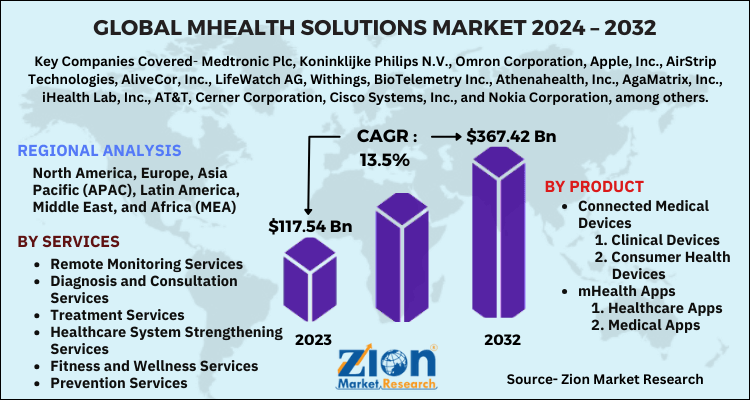mHealth Solutions Market Size, Share, Growth Report 2032

mHealth Solutions Market By Services And Products (Connected Medical Devices (Consumer Health Devices And Clinical Devices), MHealth Apps (Healthcare Apps And Medical Apps), And MHealth Services), By Region - Global And Regional Industry Overview, market Intelligence, Comprehensive Analysis, Historical Data, And Forecasts 2024-2032
| Market Size in 2023 | Market Forecast in 2032 | CAGR (in %) | Base Year |
|---|---|---|---|
| USD 117.54 Billion | USD 367.42 Billion | 13.5% | 2023 |
mHealth Solutions Market Size
The global mHealth Solutions market size was worth around USD 117.54 billion in 2023 and is predicted to grow to around USD 367.42 billion by 2032 with a compound annual growth rate (CAGR) of roughly 13.5% between 2024 and 2032.
The study provides historical data from 2018 to 2022 along with a forecast from 2024 to 2032 based on revenue (USD billion). The report covers a forecast and an analysis of the mHealth Solutions market on a global and regional level.
mHealth Solutions Market: Overview
Mobile health or mHealth is the integration of cloud computing technology and devices, such as tablets, personal digital assistants (PDAs), and smartphones, for various healthcare applications. mHealth is a cost-efficient solution for improving health outcomes and helps healthcare providers to improve productivity and reduce administrative processes. These mHealth solutions enable healthcare professionals to access patient information more proficiently and allow improved patient care.
The study includes drivers and restraints for the mHealth solutions market along with the impact they have on the demand over the forecast period. Additionally, the report includes the study of opportunities available in the mHealth solutions market on a global and regional level.
In order to give the users of this report a comprehensive overview of the mHealth solutions market, we have included a competitive landscape and an analysis of Porter’s Five Forces model for the market. The study encompasses a market attractiveness analysis, wherein all the segments are benchmarked based on their market size, growth rate, and general attractiveness.
The report provides company market share analysis to give a broader overview of the key market players. In addition, the report also covers key strategic developments of the market including acquisitions & mergers, new product launch, agreements, partnerships, collaborations & joint ventures, research & development, and regional expansion of major participants involved in the mHealth Solutions market on a global and regional basis.
mHealth Solutions Market: Growth Factors
The worldwide prevalence of life-threatening diseases is increasing due to changing lifestyle habits, sedentary lifestyle, and lack of exercise. The growing health awareness among patients is likely to boost the mHealth solutions market in the future. Additionally, the increased use of tablets, smartphones, etc. is increasing among all age groups and the penetration of third and fourth generation networks helps in providing uninterrupted health services. Healthcare professionals are focused on offering patient-centric healthcare services. The mHealth apps help maintain patient records, allow remote monitoring, consultation, and prevention and treatment services. Thus, these aforementioned factors are likely to drive the mHealth solutions market in the upcoming years. However, the lack of regulations, standards, and reimbursement policies might hamper the mHealth solutions market growth in the future.
mHealth Solutions Market: Segmentation
The study provides a decisive view of the mHealth solutions market by segmenting the market based on product and services and region.
Based on products and services, the market is segmented into mHealth applications (apps), connected medical devices, and mHealth services. Connected medical devices segment is further segmented into clinical and consumer devices. The clinical devices segment is further classified into vital signs monitoring devices and fetal monitoring devices, peak flow meters, multi-parameter trackers, sleep apnea monitors, neurological monitoring devices, and other connected medical devices. Vital signs monitoring devices are sub-segmented into blood glucose monitors, blood pressure monitors, ECG monitors/heart rate monitors, and pulse oximeters. Other clinical devices segment includes coagulation monitors, thermometers, fetal maternity monitors, and digital skin sensors.
The mHealth applications segment is divided into healthcare applications and medical applications. Healthcare applications segment is divided into chronic care management apps, general health and fitness applications, medication management apps, personal health record (PHR) apps, women’s health apps, and other healthcare apps (dermatological treatment, sleep monitoring, and emergency response (vital tracking)). General health and fitness apps are classified into weight & obesity management apps, health-tracking apps, and fitness and nutrition apps. Chronic care management apps are classified into diabetes management apps, behavioral disorder and mental health management apps, cancer therapy management apps, blood pressure & ECG monitoring apps, and other chronic care management apps (kidney disorders and respiratory diseases & infections management apps). Women’s health apps are classified into fertility apps, breastfeeding apps, pregnancy apps, and other women health apps (apps for sleep, activity, and stress level tracking). Medical apps are made for medical professionals and are classified into continuing medical education apps, consulting and communication apps, medical reference apps, and patient management & monitoring apps.
The mHealth services segment includes diagnosis and consultation services, remote monitoring, healthcare system strengthening services, treatment services, prevention services, and fitness and wellness services.
mHealth Solutions Market: Report Scope
| Report Attributes | Report Details |
|---|---|
| Report Name | mHealth Solutions Market |
| Market Size in 2023 | USD 117.54 Billion |
| Market Forecast in 2032 | USD 367.42 Billion |
| Growth Rate | CAGR of 13.5% |
| Number of Pages | 110 |
| Key Companies Covered | Medtronic Plc, Koninklijke Philips N.V., Omron Corporation, Apple, Inc., AirStrip Technologies, AliveCor, Inc., LifeWatch AG, Withings, BioTelemetry Inc., Athenahealth, Inc., AgaMatrix, Inc., iHealth Lab, Inc., AT&T, Cerner Corporation, Cisco Systems, Inc., and Nokia Corporation, among others |
| Segments Covered | By Product and Services and By region |
| Regions Covered | North America, Europe, Asia Pacific (APAC), Latin America, Middle East, and Africa (MEA) |
| Base Year | 2023 |
| Historical Year | 2018 to 2022 |
| Forecast Year | 2024 - 2032 |
| Customization Scope | Avail customized purchase options to meet your exact research needs. Request For Customization |
mHealth Solutions Market: Regional Analysis
The regional segmentation includes the current and forecast demand for North America, Europe, Asia Pacific, Latin America, and the Middle East and Africa with its further division into major countries including the U.S., Canada, Germany, France, UK, China, Japan, India, and Brazil.
The presence of advanced healthcare systems increased usage of smartphone and other devices penetration, the higher adoption rate of innovative technologies are some of the key factors that are likely to boost the North American mHealth solutions market in the future. North America held a major share, i.e., around 45%, of the global mHealth solutions market in 2018. At the country level, the U.S. is the major market for mHealth solutions in the North American region and at the global level. Europe held the second leading position in global mHealth solutions market in 2018. The Asia Pacific region is estimated to register substantial growth in the mHealth solutions market in the estimated period, owing to the presence of a large number of pharmaceutical companies.
mHealth Solutions Market: Competitive Players
Some key players of the global mHealth solutions market include:
- Medtronic Plc
- Koninklijke Philips N.V.
- Omron Corporation
- Apple Inc.
- AirStrip Technologies
- AliveCor Inc.
- LifeWatch AG
- Withings
- BioTelemetry Inc.
- Athenahealth Inc.
- AgaMatrix Inc.
- iHealth Lab Inc.
- AT&T
- Cerner Corporation
- Cisco Systems Inc.
- Nokia Corporation
The Global mHealth Solutions Market is segmented as follows:
Global mHealth Solutions Market: By Product and Services
- Connected Medical Devices
- Clinical Devices
- Vital Signs Monitoring Devices
- Blood Pressure Monitors
- Blood Glucose Meters
- ECG/Heart Rate Monitors
- Pulse Oximeters
- Peak Flow meters
- Fetal Monitoring Devices
- Multiparameter Trackers
- Sleep Apnea Monitors
- Neurological Monitoring Devices
- Other Clinical Devices
- Vital Signs Monitoring Devices
- Consumer Health Devices
- Clinical Devices
- mHealth Apps
- Healthcare Apps
- General Health and Fitness Apps
- Health Tracking Apps
- Obesity and Weight Management Apps
- Fitness and Nutrition Apps
- Chronic Care Management Apps
- Mental Health and Behavioral Disorder Management Apps
- Diabetes Management Apps
- Blood Pressure and ECG Monitoring Apps
- Cancer Therapy Management Apps
- Other Chronic Care Management Apps (Respiratory Diseases and Kidney Disorders, Infections Management Apps)
- Medication Management Apps
- Women’s Health Apps
- Pregnancy Apps
- Fertility Apps
- Breastfeeding Apps
- Other Women’s Health Apps
- Personal Health Record Apps
- Other Healthcare Apps
- General Health and Fitness Apps
- Medical Apps
- Medical Reference Apps
- Continuing Medical Education Apps
- Patient Management and Monitoring Apps
- Communication and Consulting Apps
- Healthcare Apps
- mHealth Services
- Remote Monitoring Services
- Diagnosis and Consultation Services
- Treatment Services
- Healthcare System Strengthening Services
- Fitness and Wellness Services
- Prevention Services
Global mHealth Solutions Market: By Region
- North America
- The U.S.
- Europe
- UK
- France
- Germany
- Asia Pacific
- China
- Japan
- India
- Latin America
- Brazil
- Middle East and Africa
Table Of Content
Methodology
FrequentlyAsked Questions
mHealth, or mobile health, solutions refer to the use of mobile devices and wireless technology to deliver health-related services and information.
According to study, the mHealth Solutions Market size was worth around USD 117.54 billion in 2023 and is predicted to grow to around USD 367.42 billion by 2032.
The CAGR value of mHealth Solutions Market is expected to be around 13.5% during 2024-2032.
North America has been leading the mHealth Solutions Market and is anticipated to continue on the dominant position in the years to come.
The mHealth Solutions Market is led by players like Medtronic Plc, Koninklijke Philips N.V., Omron Corporation, Apple Inc., AirStrip Technologies, AliveCor Inc., LifeWatch AG, Withings, BioTelemetry Inc., Athenahealth, Inc., AgaMatrix Inc., iHealth Lab, Inc., AT&T, Cerner Corporation, Cisco Systems Inc., and Nokia Corporation, among others.
RelatedNews
HappyClients
Zion Market Research
Tel: +1 (302) 444-0166
USA/Canada Toll Free No.+1 (855) 465-4651
3rd Floor,
Mrunal Paradise, Opp Maharaja Hotel,
Pimple Gurav, Pune 411061,
Maharashtra, India
Phone No +91 7768 006 007, +91 7768 006 008
US OFFICE NO +1 (302) 444-0166
US/CAN TOLL FREE +1 (855) 465-4651
Email: sales@zionmarketresearch.com
We have secured system to process your transaction.
Our support available to help you 24 hours a day, five days a week.
Monday - Friday: 9AM - 6PM
Saturday - Sunday: Closed






